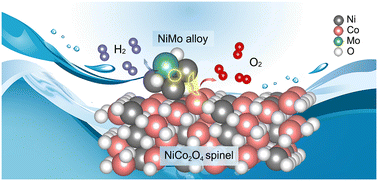Interface engineering towards overall water electrolysis over NiCo2O4/NiMo hybrid catalysts†
Abstract
The interface plays a crucial role in determining the catalytic performance during oxygen (OER) and hydrogen (HER) evolution reactions for overall water electrolysis, yet an in-depth atomic-level understanding of its function is lacking. To address this issue, we theoretically designed a hybrid catalyst comprising of a NiCo2O4 spinel and NiMo alloy (NiCo2O4/NiMo) to study the physics behind the interface by using first-principles calculations. The interface model was represented as NiCo2O4 surface anchored oxygen-coordinated Ni5Mo clusters to balance accuracy and computing load. Among the hybrid NiCo2O4/NiMo catalysts, the most effective model showed a HER ΔG*H of 0.01 eV and an OER overpotential of 0.38 V, outperforming individual components. The increased activity is linked to the three-dimensional (3D) oxidation environment at the interface, creating new active sites like moderately oxidized NiMo hollow sites and bridging Co–O–Ni bonds. This is especially important for the OER, where 3D interfacial environments avoid the formation of monodentate oxygen intermediate species and thus potentially break the linear relations between intermediate species. This study highlights the potential of interface engineering in developing advanced bifunctional electrocatalysts for water electrolysis.



 Please wait while we load your content...
Please wait while we load your content...